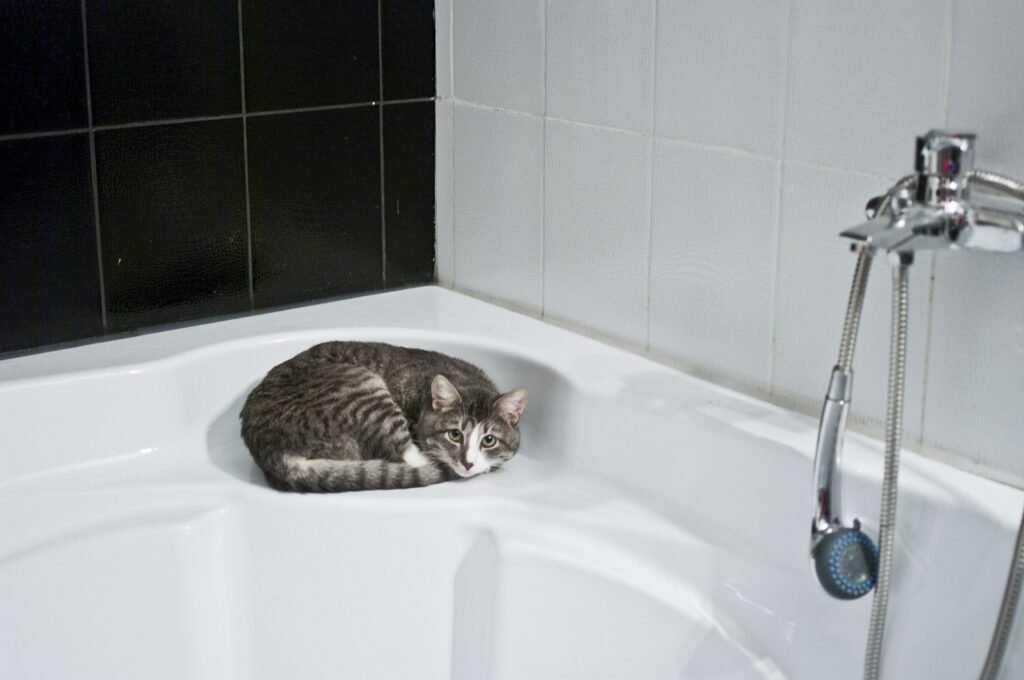
Bathing a cat is often seen as a daunting task, given their notorious reputation for disliking water. However, mastering the art of cat bathing can enhance your pet’s hygiene, health, and comfort. While cats are generally good at grooming themselves, there are times when a bath becomes necessary, such as when they get particularly dirty, encounter something sticky or harmful, or have a medical skin condition. This article will guide you through the process of bathing your feline friend with ease and confidence.
Understanding Your Cat’s Relationship with Water
Cats are known for their aversion to water, but it’s essential to understand why. In the wild, cats rarely encounter water in a way that necessitates swimming or bathing. Their coats are naturally water-resistant to some extent, offering protection from the elements. Domestic cats inherit these traits, and the unfamiliar sensation of being wet can cause anxiety. Moreover, a wet coat weighs a cat down, making them feel vulnerable.
To make the bathing process smoother, it’s crucial to introduce your cat to water gradually, ensuring they associate it with positive experiences. This can be achieved through gentle exposure and treats, which we will explore in detail later.
Preparing for the Bath
Before you even think about getting your cat wet, preparation is key. Having everything ready ensures the process is as quick and stress-free as possible, both for you and your cat.
Gathering Supplies
– **Cat Shampoo**: Use a shampoo specifically designed for cats. Human or dog shampoos can be too harsh and may cause skin irritation.
– **Towels**: Have several towels on hand for drying your cat and containing any water spills.
– **Non-slip Mat**: Place a non-slip mat in the sink or tub to prevent your cat from slipping and feeling insecure.
– **Brush**: A good brush will help remove excess fur and tangles before getting your cat wet.
– **Cup or Hose Attachment**: For rinsing, a gentle stream of water is less intimidating than a showerhead.
Setting the Environment
– **Calm Atmosphere**: Choose a quiet time when the household is calm. Turn off loud appliances and ensure there are no sudden noises.
– **Warm Room**: Cats can get cold easily, so ensure the room is warm before starting the bath.
– **Closed Space**: Close doors and windows to prevent your cat from escaping during the bath.
Introducing Your Cat to Water
Gradual introduction is vital. Start by placing your cat in an empty sink or tub, allowing them to explore the area without the stress of water. Offer treats and gentle praise to create a positive association.
Slowly introduce the sensation of water by using a damp cloth to gently moisten their fur. This helps acclimate them to the feeling without overwhelming them. With time, progress to using a cup to pour small amounts of water onto their back, always speaking soothingly and rewarding calm behavior.
The Bathing Process
Once your cat is somewhat comfortable, it’s time for the actual bath.
Step-by-Step Guide
– **Brush First**: Before wetting your cat, brush their coat thoroughly to remove loose fur and tangles. This step is crucial, as mats can become tighter when wet.
– **Wet the Coat**: Use a cup or a gentle hose attachment to wet your cat’s coat, starting from the neck and moving downwards. Avoid the head, as this can be distressing.
– **Apply Shampoo**: Lather a small amount of cat shampoo in your hands and gently massage it into your cat’s fur. Be sure to follow the instructions on the shampoo bottle regarding the amount and duration.
– **Rinse Thoroughly**: Rinse all the shampoo out of your cat’s coat using clean, lukewarm water. Any residue can irritate their skin or be ingested when they groom themselves.
– **Avoid the Head**: Use a damp cloth to gently clean your cat’s face, avoiding the eyes, ears, and nose.
Post-Bath Care
After the bath, it’s crucial to dry your cat thoroughly. Cats are sensitive to cold, and a wet coat can lower their body temperature.
Drying Your Cat
– **Towel Dry**: Wrap your cat in a soft, absorbent towel and gently pat them dry. Avoid rubbing, as this can cause discomfort and tangling.
– **Warm Environment**: Keep your cat in a warm room until they are completely dry. If your cat tolerates it, you can use a hairdryer on the lowest heat setting, maintaining a safe distance to avoid burns.
Reward and Reassure
Reward your cat with their favorite treats and lots of affection after the bath. This reinforces the idea that bath time is a positive experience and helps reduce anxiety for future baths.
Special Considerations
Some cats, especially those with long hair or certain breeds, may have specific bathing needs. For instance, Persian cats require regular baths to maintain their coat’s health and appearance.
Professional Grooming
If your cat is particularly difficult to bathe or has specific grooming needs, consider seeking help from a professional groomer. They have the tools and expertise to manage even the most challenging cats.
Conclusion
Mastering the art of cat bathing is a valuable skill that can significantly benefit your pet’s health and well-being. By understanding your cat’s behavior, preparing adequately, and following a gentle bathing process, you can make bath time a manageable and even enjoyable experience. Remember, patience and positivity are key. With practice, both you and your feline friend will approach bath time with less stress and more confidence.
Final Thoughts
Every cat is unique, and what works for one may not work for another. It’s essential to be attentive to your cat’s reactions and adjust your approach accordingly. With time, your cat may not only tolerate baths but even come to enjoy the fresh, clean feeling they bring. By mastering the art of cat bathing, you contribute to your pet’s overall hygiene and build a stronger bond based on trust and care.
#ChatGPT assisted in the creation of this article.






